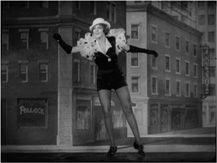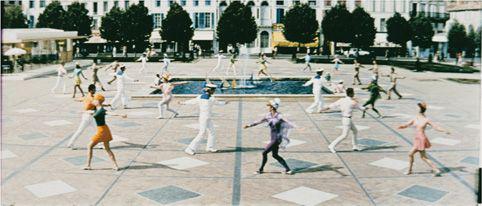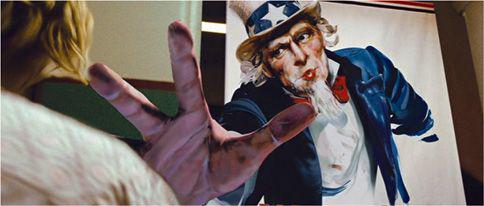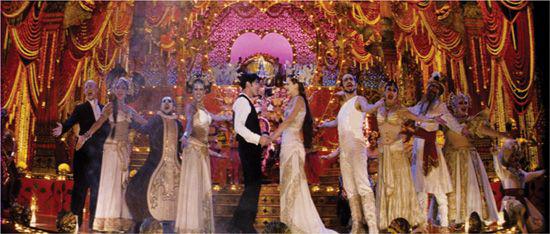Authors: David Bordwell,Kristin Thompson
B0041VYHGW EBOK (139 page)
Two typical plot patterns of the musical emerged during the 1930s. One of these was the
backstage musical,
with the action centering on singers and dancers who perform for an audience within the story world. Warner Bros.’s successful early musical,
42nd Street
(1933), set the classic pattern for backstage musicals by casting dancer Ruby Keeler as the understudy for a big musical star who breaks her leg just before the big opening. The director tells Keeler, “You’re going out a youngster, but you’ve
got
to come back a star!” and indeed she wins the audience’s cheers
(
9.18
).
During the decade, Warner’s elaborately choreographed Busby Berkeley musicals, MGM’s pairing of the youthful Judy Garland and Mickey Rooney in a series of “Let’s put on a show!” plots, and RKO’s elegant cycle of films starring the dance team of Fred Astaire and Ginger Rogers all established the conventions of the backstage musical. Later examples included musicals where the characters are film performers, as in
Singin’ in the Rain
(1952). More recent backstage musicals are
The Commitments, That Thing You Do!, What’s Love Got to Do with It,
and
Dreamgirls.

9.18 Ruby Keeler hoofs her way to stardom in
42nd Street
’s title number.
Not all musicals take place in a show business situation, however. There is also the
straight musical,
where people may sing and dance in situations of everyday life. Even in backstage musicals, the characters occasionally break into song in an everyday setting. Straight musicals are often romantic comedies, in which characters typically trace the progress of their courtship by breaking into song to express their fears, longings, and joys. We analyze one such film,
Meet Me in St. Louis,
in
Chapter 11
. In 1968, a French director took the romantic musical to extremes by having his characters in
The Young Girls of Rochefort
sing most of the dialogue in the film, with dozens of passersby joining in dance numbers staged in the town’s streets
(
9.19
).
More recently, Julie Taymor blends romance and social history in
Across the Universe
(
9.20
).

9.19 The citizens of a whole town are drawn into the dance in
The Young Girls of Rochefort.

9.20 In
Across the Universe,
a young man taking his army draft physical is greeted by the Beatles song “I Want You.”
In both backstage and straight musicals, the numbers are often associated with romance. Often the hero and heroine realize that they form the perfect romantic couple because they perform beautifully together. This happens in
Top Hat
when the Ginger Rogers character sheds her original annoyance with Fred Astaire during the “Isn’t It a Wonderful Day” number, and by the end, they have clearly fallen in love. This plot device has remained a staple of the genre. Astaire again charms his reluctant partner, this time Cyd Charisse, in the “Dancing in the Dark” number in
The Band Wagon
(1953), and John Travolta meets his romantic match on the disco dance floor in
Saturday Night Fever
(1977). In
Moulin Rouge!
the lovers serenade each other, both onstage and off, with classic pop and rock songs
(
9.21
),
and the dance interludes in the
House Party
series often become courtship rituals.

9.21 A flamboyant onstage musical number in
Moulin Rouge!
centers on the rapturous lovers.
Musicals have long been associated with children’s stories, from
The Wizard of Oz
to recent films such as
Lilo and Stitch.
Many animated features contain musical numbers, a practice going back to Disney’s
Snow White and the Seven Dwarfs.
But adult-oriented musicals have taken on somber, even tragic, material.
West Side Story
portrays a romance that tragically crosses ethnic lines, and
Pennies from Heaven
evokes the bleak atmosphere of the Depression through characters who lip-synch to recordings from that era. Biopics of performers, such as
Lady Sings the Blues, Ray,
and
Walk the Line,
become somber backstage musicals.
Still, while the Western and the horror film may explore the darker side of human nature, Hollywood musicals tend to accentuate the positive. High ambitions are rewarded when the show is a hit, and lovers are united in song and dance. In
The Pajama Game,
a strike is averted when the leaders of the union and management become a romantic couple. Some of these conventions persist today.
School of Rock
reconfirms the backstage musical’s theme that talent and hard work will eventually win out. Even the grittier
8 Mile
follows the traditional plot pattern showing a gifted young performer overcoming disadvantages and finding success.
The range of subject matter in musicals is so broad that it may be hard to pin down specific iconography associated with the genre. Yet the backstage musical at least had its characteristic settings: the dressing rooms and wings of a theater, the flats and backdrops of the stage (as in
9.18
), and the nightclub with orchestra and dance floor. Similarly, performers in these musicals are often recognizable by their distinctive stage costumes. During the 1930s, Fred Astaire wore the most famous top hat in the cinema, a hat so closely associated with his musicals that the beginning of
The Band Wagon
—where Astaire plays a washed-up movie actor—could make a joke about it. Similarly, Travolta’s white suit in
Saturday Night Fever
became an icon of the disco era. Opportunities for novelty have always been present in the musical, however, as the musical numbers set in a factory (
The Pajama Game
) or in the prairie (
Oklahoma
) indicate.
The characteristic techniques of the musical are similarly diverse. Musicals tend to be brightly lit, to set off the cheerful costumes and sets and to keep the choreography of the dance numbers clearly visible. For similar reasons, color film stock was applied quite early to musicals, including Eddie Cantor’s
Whoopee!
and, as we saw in
Chapter 2
,
The Wizard of Oz.
In order to show off the patterns formed by the dancers in musical numbers, crane shots and high angles are common. One technique widely used in the musical is not usually evident to viewers: lip-synching to prerecorded songs. On the set, they move their lips in synchronization to a playback of the recording. This technique allows the singers to move about freely and to concentrate on their acting.
CONNECT TO THE BLOG
We discuss other genres on our blog. For the relationship between fantasy and sci-fi films in recent years, see “Swords vs. lightsabers,” at
www.davidbordwell.net/blog/?p=788
.
For movies based on superhero comic books, see “Superheroes for sale,” at
www.davidbordwell.net/blog/?p=2713
.
The 1935 RKO Astaire–Rogers musical
Swing Time
is one of the exemplary backstage musicals. Early in the film, the hero, a gambler and tap dancer nicknamed Lucky, is trying to quit his stage act and get married. At once, we sense that his fiancée is not right for him; she is not a dancer (and is not even seen during the early scenes in which his colleagues try to trick him into missing the wedding). The opening scenes take place in the conventional settings of the stage, wings, and dressing room of a theater. Later, when Lucky goes to the city and meets the heroine, Penny (a name that echoes Lucky’s precious lucky quarter), she quickly takes a strong dislike to him. An amusing scene in the dance school where she works has Lucky pretending to be hopelessly clumsy. Yet when the school’s owner fires Penny, Lucky saves her job by suddenly launching into a graceful, virtuoso, and unrehearsed dance with her. By the end, her animosity has disappeared, and the school owner sets the two up to audition at a fashionable club.
Obstacles ensue, primarily in the form of a romantic rivalry between Lucky and the orchestra leader at the club. Further complications result when Penny believes mistakenly that Lucky intends to return to his fiancée. Near the end, Penny seems about to abandon Lucky to marry the conductor. She and Lucky meet, apparently for the last time, and their talk at cross-purposes reveals the link between performance and romance:
PENNY: “Does she dance very beautifully?”
LUCKY: “Who?”
PENNY: “The girl you’re in love with?”
LUCKY: “Yes—very.”
PENNY: “The girl you’re going to marry.”
LUCKY: “Oh, I don’t know. I’ve danced with you. I’m never going to dance again.”
That Fred Astaire will never dance again is the ultimate threat, and his song “Never Gonna Dance” leads into a duet that reconfirms that they are meant for each other. In the end, Lucky and Penny reconcile.
The film calls on the newly established conventions of the genre. Lucky wears Astaire’s classic top hat and formal clothes
(
9.22
).
Astaire and Rogers dance in the art deco–style sets that were typical of musical design in the 1930s
(
9.23
).
The film departs from convention, however, in a remarkable number, “Bojangles of Harlem,” where Astaire pays tribute to the great African-American dancers who had influenced him during his New York stage career in the 1920s. When he appears in blackface here, it is not to exploit a demeaning stereotype but to impersonate Bill “Bojangles” Robinson, the most famous black tap dancer of the era. (The tribute is all the more unusual because Robinson was then costarring in Shirley Temple musicals for a rival studio, Twentieth Century Fox.)
